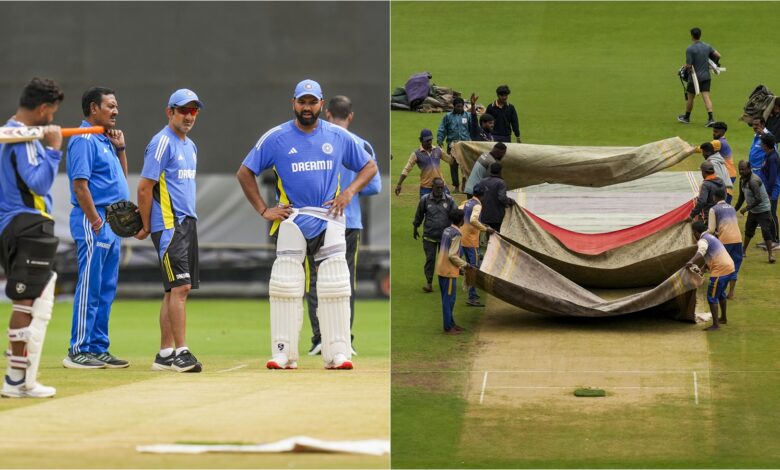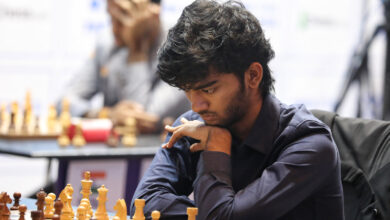Rain-affected Bengaluru Test pitch to aid spin or pace? Doesn’t matter as India’s world-class bowlers have ended old pitch-doctoring habit | Cricket News

The conversations on the eve of the first Test between India and New Zealand in Bangalore centred on the rain that has washed the city. On the depression forming in the Bay of Bengal, named Invest 96B, which sounds more like an Income Tax law rather than a weather phenomenon, the clockwork drainage system that would ensure a Kanpur-scale fiasco is not repeated, the reeling traffic, the clogging roads, and the best weather apps. The incessant rain also robbed a favourite pregame narrative. The mystery of the 22 yards, which remained wrapped under a blue, firm tarpaulin sheet. It could also be that the days of palace intrigues and conspiracies have passed. Rohit Sharma’s men are so unbreakable at home that they needn’t coax undue favours from the pitch. A near-perfect squad, flexible and balanced, they could as well check in an hour before the toss, fathom the mysteries of the surface and l out the playing eleven in the twitch of a finger. Rain or sun, fire or flood, the surface spinning or seaming his team finds its rhymes and rhythms, its winning routines grooved and drilled.
So Rohit Sharma was not quizzed on how many spinners he would pack in the side, or whether the ball would turn from the first hour. Similarly, Tom Latham was not probed on whether his batsmen are equipped to deal the spin ordeal, or poked to say that India are stretching home advantage to an extreme scale. The questions that surrounded the pitch were benign in tone, on whether the underlying moure would tempt a three-man pace pack. It was a silent admission that India are no longer hostages of the surface.
Bengaluru 📍
A mix of nostalgia and fun 🏡
Presenting “Namma Maga” ~ KL Rahul 😎
WATCH 🎥🔽 – @28anand | #TeamIndia | #INDvNZ | @IDFCFIRSTBank | @klrahul pic.twitter.com/GXs6bbc4Mt
— BCCI (@BCCI) October 15, 2024
Turner-dependence, thus, is a passé. It has been progressively waning over the course of this decade. The start of the Ravi Shastri era witnessed an unabashed fixation on turners. The circumstances were different too. India were transitioning. Jasprit Bumrah was just another IPL freak; Mohammed Shami was inconsent and injury-prone; Ravindra Jadeja and Ravi Ashwin were yet to mature into a deadly double-act. The cogs that make this slick machine work were jarring and rebelling. Turners, thus, were a reaction to a dark time in Indian cricket. When Rahul Dravid inherited, the team was on a descent after the peaks of Australia. In the relentless race for the World Test Championship mace, Dravid sought compromises. Turners were not the default tactic, but a stand one when push came to shove. In the sunset of his coaching tenure, India had perceptibly veered away from spin-crucible. Except arguably Hyderabad, the decks for the England series, were not too skewed to cause batsmen nightmares.
Months later, Gambhir has winked in his era with the standard Indian wickets. That is, he has not meddled with the original characterics of the pitch. The Chennai one was true to its nature—sufficient bounce and carry, a modicum of movement for the seamers with the new before it settles down for batsmen to pile the runs. Kanpur was typically slow and low, the intermittent rain producing a hint of lateral movement for the seamers. Some degree of turn is invariable, just as bounce is inevitable in Australia, and swing in England. Only that curators don’t end up stitching together disparate parts to become an incongruous whole.
💬💬 Our focus is to improve and better our performance.#TeamIndia Captain Rohit Sharma ahead of the #INDvNZ Test series 👌👌@IDFCFIRSTBank | @ImRo45 pic.twitter.com/mJMOvVgVDw
— BCCI (@BCCI) October 15, 2024
The new head coach doesn’t spend too much type pitch gazing either. He is brisk in his manners. On Monday, he leant over and tapped a few spots on either ends, mostly around the seamer’s good length. But then swiftly returned to the nets. There was no selective watering, which had been a familiar sight, either. These are nascent days, but the signs are that India have unchained themselves from decades of turner-obsession.
A few realisations could have influenced him. Primarily, their spinners are the most lethal in the world. At an exalted stage of their career, they transcend surfaces, have multiple layers of deceit and impose psychologically on batsmen. Interestingly, they have snared more wickets when the ball had not been turning outlandishly. The two themselves, with more wickets than any other spin-twins are good enough to run through an opposition.
But unlike in the past when they came to bowl as early as tenth over, the seamers make them wait. Invariably, they either blow up the top order or soften them up. Like the spinners, the traits of the pitch don’t affect them. In favourable conditions they are hellish, in unfavourable climes, they are devilish. Most coaches and captain would feel like it is a travesty to reduce them to one or two bursts a day. Like in Kanpur and Chennai recently, or in Visakhapatnam and Ranchi, they stole the thunder from the spinners on flaccid tracks. When a team has such a formidable attack, the behaviour of the pitch turns irrelevant. The gulf between India and all teams in the subcontinent is so wide that it doesn’t need any widening in the guise of pitch-doctoring.
#TeamIndia 🇮🇳 is back in whites 🤍
One sleep away from Test No.1#INDvNZ | @IDFCFIRSTBank | @ashwinravi99 pic.twitter.com/lzVQCrtaLh
— BCCI (@BCCI) October 15, 2024
The other significant corollary is the diminishing prowess of India’s batsmen in negotiating spinners on turning tracks. Barring Rohit Sharma, the rest have endured spin travails quite frequently. The era of rubbery-limbed batsmen destroying spinners like it were all a child’s play is a vestige of the past. The generation that bossed two of the greatest spinners of all time—Shane Warne and Muttiah Muralitharan—have long sunk into the horizon. Obscure spinners from different corners have harassed them, be it Ajaz Patel, Shoaib Basheer, Steve’O Keefe, or Matthew Kuhnemann. An outright turner could gloriously backfire, catapulting journeymen spinners to overnight fame. The risks thus far outweigh the rewards.
So the attention, over the next five days, would be on checking weather apps and interpreting cloud formations rather than the 22 yards, wrapped in blue tarpaulin under a cascade of water.







